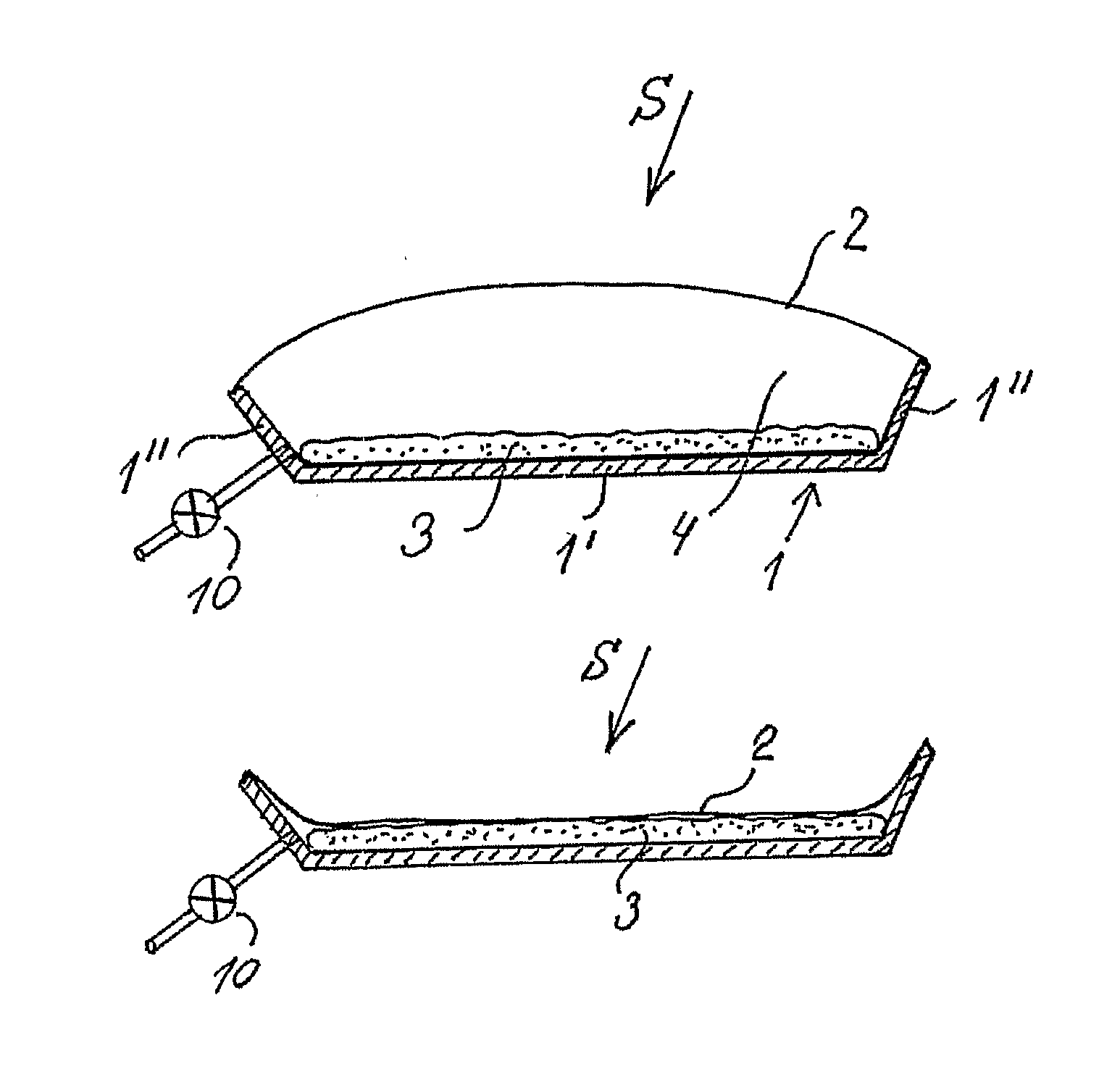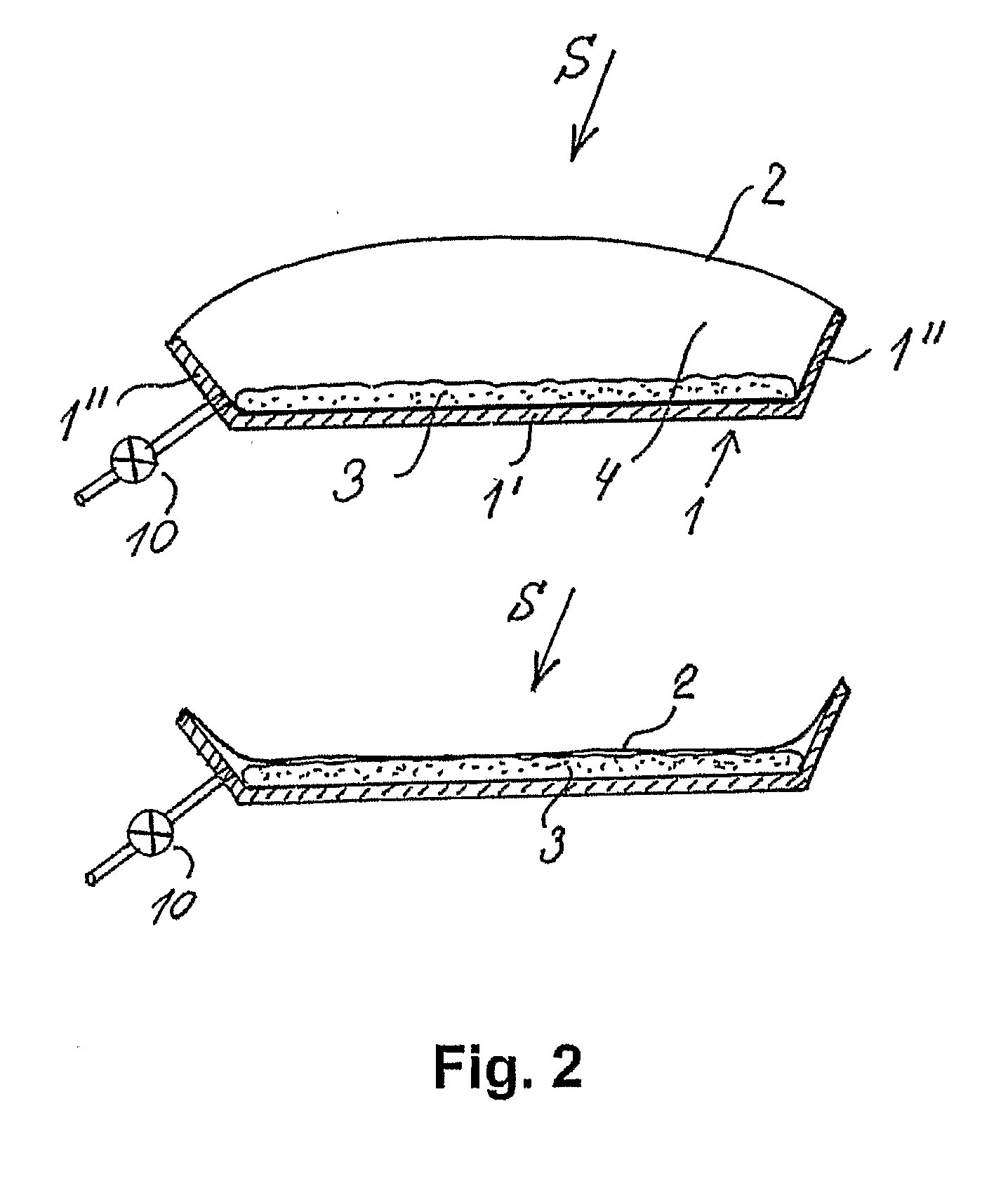Method, device and system for altering the reverberation time of a room
a technology for altering the reverberation time and rooms, applied in the direction of frequency/directions obtaining arrangements, sound producing devices, building components, etc., can solve the problems of unfavorable “boomy” reproduction of sounds in the room, loss of perceived details of music, and even speech intelligibility, and selective reduction of reverberation time at low frequencies is somewhat more difficult to implement. , the effect of reducing the reverberation time and reducing th
- Summary
- Abstract
- Description
- Claims
- Application Information
AI Technical Summary
Benefits of technology
Problems solved by technology
Method used
Image
Examples
first embodiment
[0047] Referring to FIG. 2 there is now shown a schematic representation of a device according to the invention comprising a substantially rigid frame structure 1 comprising edge portions 1″ surrounding a central portion 1′, thus forming an open box- or tray-like support structure. Opposite the central portion 1′ and supported by the edge portions 1″ is suspended a thin, flexible membrane 2. The frame structure and the membrane define an internal cavity 4 which can be inflated / deflated with air or another suitable gas via a conduit and valve arrangement indicated by reference numeral 10. The cavity 4 may optionally be provided with a certain amount of acoustic damping material, for instance in the form of a panel 3 of porous material provided at the central portion 1′ or in the form of a suspended sheet of fabric with suitable flow resistance, suspended between the edge portions 1″ at a suitable distance from the central portion 1′. In the inflated state, acoustic energy of an incid...
second embodiment
[0051] Thus, FIGS. 4a, 4b and 4c show a schematic representation of different versions of a device according to the invention of a “mattress” configuration. As shown in FIG. 4a, the device may have the rectangular shape of a traditional mattress comprising upper and lower (not visible) substantially planar surfaces 5 bounded by edge portions 7′, 7″, thus forming an internal cavity in the mattress. Both the planar portions 5 and the edge portions 7′, 7″ are made of a suitable flexible material whereby the mattress can be brought into an inflated state as shown in FIG. 4a by the provision of air or other gas under pressure via an inlet 10 with suitable valve means. In order to maintain the inflated mattress in its proper substantially rectangular shape, cross connections 6 are provided internally between the two opposing planar surfaces 5, as is well known in itself. It is understood that other shapes of the mattress than the rectangular shape shown in FIG. 4a could also be envisaged ...
third embodiment
[0053]FIG. 5 shows a schematic representation of a device according to the invention of the collapsible type comprising an inflatable frame structure 8′, 8″ for suspension of at least one flexible membrane 9, although one of these may also be a substantially rigid panel as in the previous embodiment. The frame structure may be provided by the hollow toroidal structure 8′ and 8″ shown in FIG. 5 and inflated with air at a pressure p1 above atmospheric pressure via the inlet and valve member 11 in order to attain a relatively rigid frame structure. Suspended over this frame structure is either one or two flexible membranes 9, whereby a cavity 12 is formed between the membranes. The cavity 12 can be varied (inflated / deflated) by controlling the pressure p2 of air or other gas within the cavity, the cavity being also provided with inlet and valve means 10. Also in this embodiment, other shapes than the cylindrical shape shown may of course be envisaged without departing from the inventio...
PUM
 Login to View More
Login to View More Abstract
Description
Claims
Application Information
 Login to View More
Login to View More - R&D
- Intellectual Property
- Life Sciences
- Materials
- Tech Scout
- Unparalleled Data Quality
- Higher Quality Content
- 60% Fewer Hallucinations
Browse by: Latest US Patents, China's latest patents, Technical Efficacy Thesaurus, Application Domain, Technology Topic, Popular Technical Reports.
© 2025 PatSnap. All rights reserved.Legal|Privacy policy|Modern Slavery Act Transparency Statement|Sitemap|About US| Contact US: help@patsnap.com



